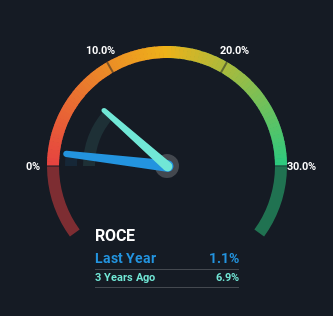If we want to find a stock that could multiply over the long term, what are the underlying trends we should look for? One common approach is to try and find a company with returns on capital employed (ROCE) that are increasing, in conjunction with a growing amount of capital employed. Ultimately, this demonstrates that it's a business that is reinvesting profits at increasing rates of return. In light of that, when we looked at Walsin Lihwa (TWSE:1605) and its ROCE trend, we weren't exactly thrilled.
What Is Return On Capital Employed (ROCE)?
If you haven't worked with ROCE before, it measures the 'return' (pre-tax profit) a company generates from capital employed in its business. To calculate this metric for Walsin Lihwa, this is the formula:
Return on Capital Employed = Earnings Before Interest and Tax (EBIT) ÷ (Total Assets - Current Liabilities)
0.011 = NT$2.4b ÷ (NT$262b - NT$54b) (Based on the trailing twelve months to September 2024).
Therefore, Walsin Lihwa has an ROCE of 1.1%. In absolute terms, that's a low return and it also under-performs the Electrical industry average of 8.2%.
Check out our latest analysis for Walsin Lihwa

In the above chart we have measured Walsin Lihwa's prior ROCE against its prior performance, but the future is arguably more important. If you'd like, you can check out the forecasts from the analysts covering Walsin Lihwa for free.
The Trend Of ROCE
On the surface, the trend of ROCE at Walsin Lihwa doesn't inspire confidence. Over the last five years, returns on capital have decreased to 1.1% from 2.9% five years ago. However it looks like Walsin Lihwa might be reinvesting for long term growth because while capital employed has increased, the company's sales haven't changed much in the last 12 months. It may take some time before the company starts to see any change in earnings from these investments.
The Key Takeaway
In summary, Walsin Lihwa is reinvesting funds back into the business for growth but unfortunately it looks like sales haven't increased much just yet. Although the market must be expecting these trends to improve because the stock has gained 85% over the last five years. However, unless these underlying trends turn more positive, we wouldn't get our hopes up too high.
Since virtually every company faces some risks, it's worth knowing what they are, and we've spotted 4 warning signs for Walsin Lihwa (of which 2 make us uncomfortable!) that you should know about.
For those who like to invest in solid companies, check out this free list of companies with solid balance sheets and high returns on equity.
Valuation is complex, but we're here to simplify it.
Discover if Walsin Lihwa might be undervalued or overvalued with our detailed analysis, featuring fair value estimates, potential risks, dividends, insider trades, and its financial condition.
Access Free AnalysisHave feedback on this article? Concerned about the content? Get in touch with us directly. Alternatively, email editorial-team (at) simplywallst.com.
This article by Simply Wall St is general in nature. We provide commentary based on historical data and analyst forecasts only using an unbiased methodology and our articles are not intended to be financial advice. It does not constitute a recommendation to buy or sell any stock, and does not take account of your objectives, or your financial situation. We aim to bring you long-term focused analysis driven by fundamental data. Note that our analysis may not factor in the latest price-sensitive company announcements or qualitative material. Simply Wall St has no position in any stocks mentioned.
About TWSE:1605
Walsin Lihwa
Engages in the manufacture and sale of wires and cables, and stainless-steel products in Asia, the United States, Europe, and internationally.
Adequate balance sheet with slight risk.
Similar Companies
Market Insights
Community Narratives



